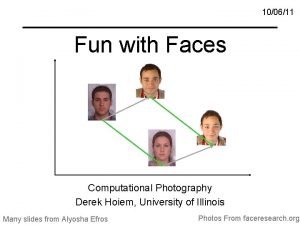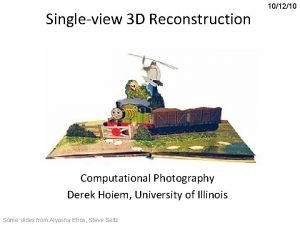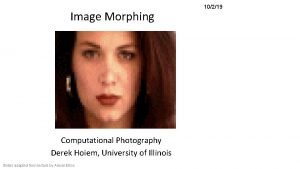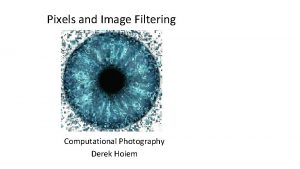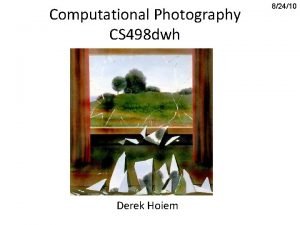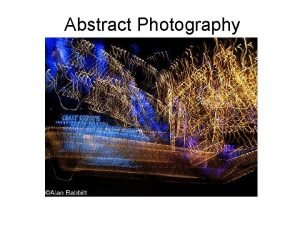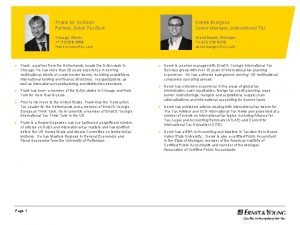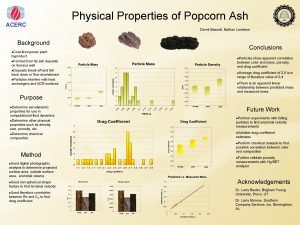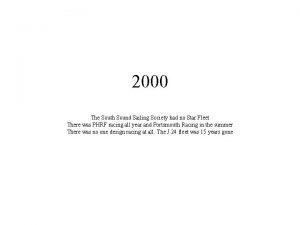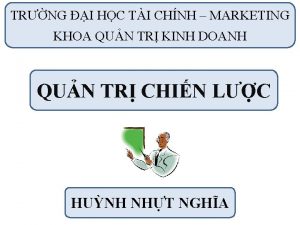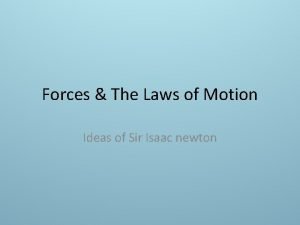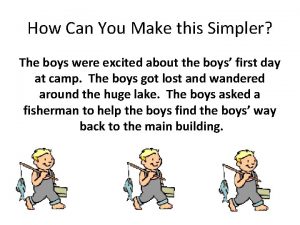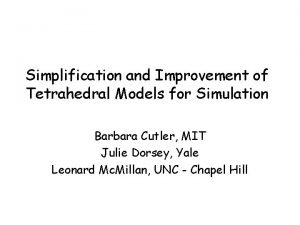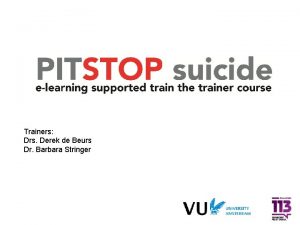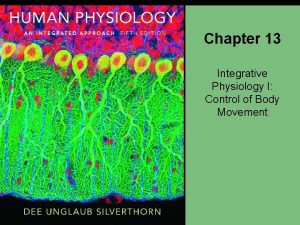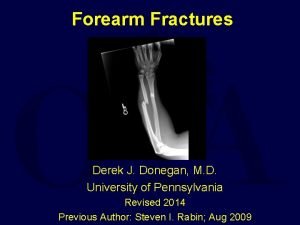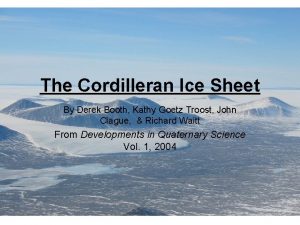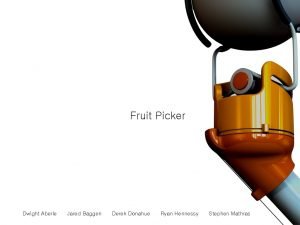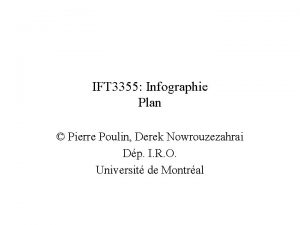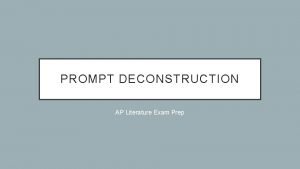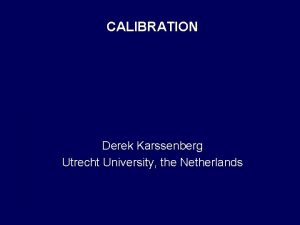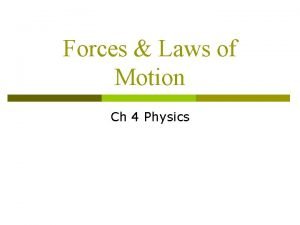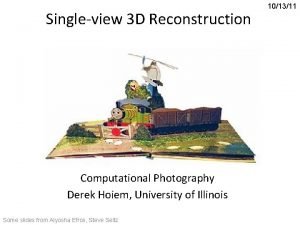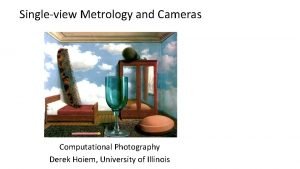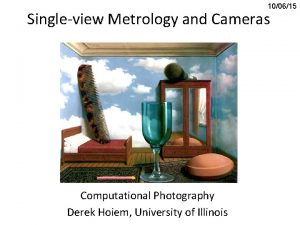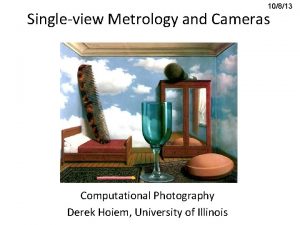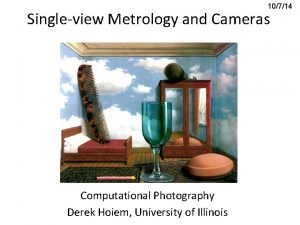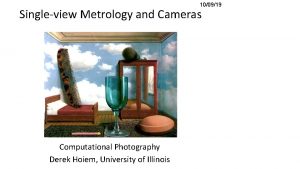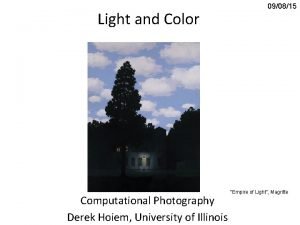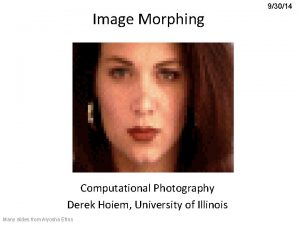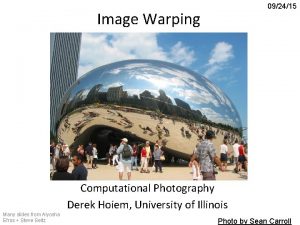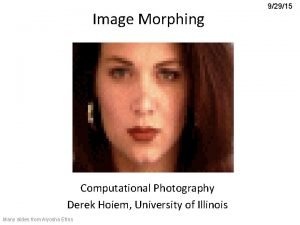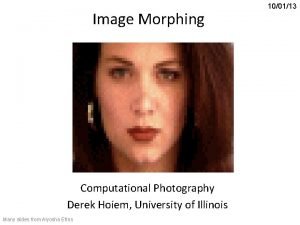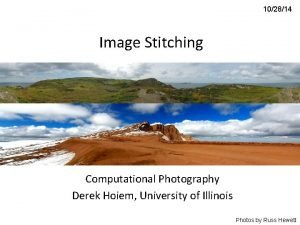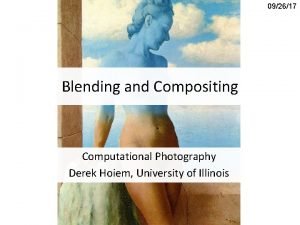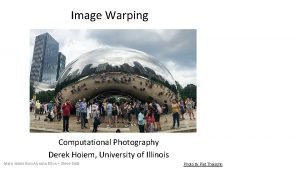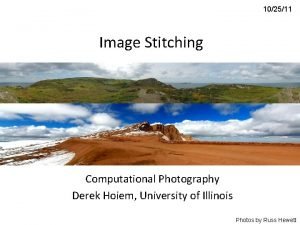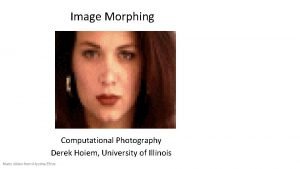Singleview 3 D Reconstruction Computational Photography Derek Hoiem















































![Comparison with Manual Method [Liebowitz et al. 1999] Input Image Automatic Photo Pop-up (15 Comparison with Manual Method [Liebowitz et al. 1999] Input Image Automatic Photo Pop-up (15](https://slidetodoc.com/presentation_image_h/2d255552c93748a774429049c0b4e262/image-48.jpg)







- Slides: 55

Single-view 3 D Reconstruction Computational Photography Derek Hoiem, University of Illinois Some slides from Alyosha Efros, Steve Seitz 10/18/12

Take-home question Suppose you have estimated three vanishing points corresponding to orthogonal directions. How can you recover the rotation matrix that is aligned with the 3 D axes defined by these points? – Assume that intrinsic matrix K has three parameters – Remember, in homogeneous coordinates, we can write a 3 d point at infinity as (X, Y, Z, 0) VPy VPx Photo from online Tate collection . VPz

Take-home question Assume that the camera height is 5 ft. – What is the height of the man? – What is the height of the building?


Difficulty in macro (close-up) photography • For close objects, we have a small relative DOF • Can only shrink aperture so far How to get both bugs in focus?

Solution: Focus stacking 1. Take pictures with varying focal length Example from http: //www. wonderfulphotos. com/articles/macro/focus_stacking/

Solution: Focus stacking 1. Take pictures with varying focal length 2. Combine

Focus stacking http: //www. wonderfulphotos. com/articles/macro/focus_stacking/

Focus stacking How to combine? Web answer: With software (Photoshop, Combine. ZM) How to do it automatically?

Focus stacking How to combine? 1. Align images (e. g. , using corresponding points) 2. Two ideas a) Mask regions by hand combine with pyramid blend b) Gradient domain fusion (mixed gradient) without masking Automatic solution would make a very interesting final project Recommended Reading: http: //www. digital-photographyschool. com/an-introduction-to-focusstacking http: //www. zen 20934. zen. co. uk/photograp hy/Workflow. htm#Focus%20 Stacking

Relation between field of view and focal length Field of view (angle width) Film/Sensor Width Focal length

Dolly Zoom or “Vertigo Effect” http: //www. youtube. com/watch? v=NB 4 bikr. Nz. Mk How is this done? Zoom in while moving away http: //en. wikipedia. org/wiki/Focal_length

Dolly zoom (or “Vertigo effect”) Field of view (angle width) Film/Sensor Width Focal length width of object Distance between object and camera

Today’s class: 3 D Reconstruction

The challenge One 2 D image could be generated by an infinite number of 3 D geometries ? ? ?

The solution Make simplifying assumptions about 3 D geometry Unlikely Likely

Today’s class: Two Models • Box + frontal billboards • Ground plane + non-frontal billboards

“Tour into the Picture” (Horry et al. SIGGRAPH ’ 97) Create a 3 D “theatre stage” of five billboards Specify foreground objects through bounding polygons Use camera transformations to navigate through the scene Following slides modified from Efros

The idea Many scenes can be represented as an axis-aligned box volume (i. e. a stage) Key assumptions • All walls are orthogonal • Camera view plane is parallel to back of volume How many vanishing points does the box have? • Three, but two at infinity • Single-point perspective Can use the vanishing point to fit the box to the particular scene

Fitting the box volume • User controls the inner box and the vanishing point placement (# of DOF? ? ? ) • Q: What’s the significance of the vanishing point location? • A: It’s at eye (camera) level: ray from COP to VP is perpendicular to image plane – Under single-point perspective assumptions, the VP should be the principal point of the image

Example of user input: vanishing point and back face of view volume are defined High Camera

Example of user input: vanishing point and back face of view volume are defined Low Camera

Comparison of how image is subdivided based on two different camera positions. You should see how moving the box corresponds to moving the eyepoint in the 3 D world. High Camera Low Camera

Another example of user input: vanishing point and back face of view volume are defined Left Camera

Another example of user input: vanishing point and back face of view volume are defined Right Camera

Comparison of two camera placements – left and right. Corresponding subdivisions match view you would see if you looked down a hallway. Left Camera Right Camera

Question • Think about the camera center and image plane… – What happens when we move the box? – What happens when we move the vanishing point?

2 D to 3 D conversion • First, we can get ratios left right top vanishing point back plane bottom

2 D to 3 D conversion Size of user-defined back plane determines width/height throughout box (orthogonal sides) Use top versus side ratio to determine relative height and width dimensions of box Left/right and top/bot ratios determine part of 3 D camera placement left right top camera pos bottom

Depth of the box • Can compute by similar triangles (CVA vs. CV’A’) • Need to know focal length f (or FOV) • Note: can compute position on any object on the ground – Simple unprojection – What about things off the ground?

Homography 2 d coordinates 3 d plane coordinates A C A’ B’ D B C’ D’

Image rectification p p’ To unwarp (rectify) an image solve for homography H given p and p’: wp’=Hp

Computing homography Assume we have four matched points: How do we compute homography H? Direct Linear Transformation (DLT)

Computing homography Direct Linear Transform • Apply SVD: UDVT = A • h = Vsmallest (column of V corr. to smallest singular value) Matlab [U, S, V] = svd(A); h = V(: , end); Explanations of SVD and solving homogeneous linear systems

Tour into the picture algorithm 1. Set the box corners

Tour into the picture algorithm 1. Set the box corners 2. Set the VP 3. Get 3 D coordinates – Compute height, width, and depth of box 4. Get texture maps – homographies for each face x

Result Render from new views http: //www. cs. cmu. edu/afs/cs. cmu. edu/academic/class/15463 -f 08/www/proj 5/www/dmillett/

Foreground Objects Use separate billboard for each For this to work, three separate images used: – Original image. – Mask to isolate desired foreground images. – Background with objects removed

Foreground Objects Add vertical rectangles for each foreground object Can compute 3 D coordinates P 0, P 1 since they are on known plane. P 2, P 3 can be computed as before (similar triangles)

Foreground Result Video from CMU class: http: //www. youtube. com/watch? v=d. UAtd m. Gwcu. M

Automatic Photo Pop-up Input Geometric Labels Cut’n’Fold 3 D Model Ground Image Vertical Learned Models Sky Hoiem et al. 2005

Cutting and Folding • Fit ground-vertical boundary – Iterative Hough transform

Cutting and Folding • Form polylines from boundary segments – Join segments that intersect at slight angles – Remove small overlapping polylines • Estimate horizon position from perspective cues

Cutting and Folding • ``Fold’’ along polylines and at corners • ``Cut’’ at ends of polylines and along vertical-sky boundary

Cutting and Folding • Construct 3 D model • Texture map

Results http: //www. cs. illinois. edu/homes/dhoiem/projects/popup/ Input Image Cut and Fold Automatic Photo Pop-up

Results Input Image Automatic Photo Pop-up
![Comparison with Manual Method Liebowitz et al 1999 Input Image Automatic Photo Popup 15 Comparison with Manual Method [Liebowitz et al. 1999] Input Image Automatic Photo Pop-up (15](https://slidetodoc.com/presentation_image_h/2d255552c93748a774429049c0b4e262/image-48.jpg)
Comparison with Manual Method [Liebowitz et al. 1999] Input Image Automatic Photo Pop-up (15 sec)!

Failures Labeling Errors

Failures Foreground Objects

Adding Foreground Labels Recovered Surface Labels + Ground-Vertical Boundary Fit Object Boundaries + Horizon


Final project ideas • If a one-person project: – Interactive program to make 3 D model from an image (e. g. , output in VRML, or draw path for animation) • If a two-person team, 2 nd person: – Add tools for cutting out foreground objects and automatic hole-filling

Summary • 2 D 3 D is mathematically impossible • Need right assumptions about the world geometry • Important tools – Vanishing points – Camera matrix – Homography

Next Week • Monday: Project 3 is due – Office hours at 3 pm today, 10 am Monday • Next Tuesday: start of new section – Finding correspondences automatically – Image stitching – Various forms of recognition
 Derek hoiem
Derek hoiem Derek hoiem
Derek hoiem Derek hoiem
Derek hoiem Computational photography uiuc
Computational photography uiuc Computational photography uiuc
Computational photography uiuc Is abstract photography same as conceptual photography
Is abstract photography same as conceptual photography Derek burgess
Derek burgess Emily paust
Emily paust Adfreeze forces on piles
Adfreeze forces on piles Derek peacock
Derek peacock Physical properties of popcorn
Physical properties of popcorn Derek donkin
Derek donkin Derek england
Derek england Derek lan
Derek lan Cots cissp
Cots cissp Derek jan fikkers
Derek jan fikkers South sound sailing society
South sound sailing society Derek wasnock
Derek wasnock Ma trận ie
Ma trận ie Derek leaves his physics book on top of a drafting table
Derek leaves his physics book on top of a drafting table Derek walcott fay moston
Derek walcott fay moston Derek martin nude
Derek martin nude Derek li group
Derek li group Derek harter
Derek harter Everyone should bring ___ mother to the picnic
Everyone should bring ___ mother to the picnic Derek farnsworth
Derek farnsworth Derek paiz
Derek paiz Derek farnsworth
Derek farnsworth Derek bruening
Derek bruening Dr derek jones
Dr derek jones Takoyaki karamunsing
Takoyaki karamunsing Derek de beurs
Derek de beurs Proprioceptors
Proprioceptors Derek comartin
Derek comartin Derek donegan
Derek donegan Derek booth hockey
Derek booth hockey Feature slices
Feature slices Dr derek lovell psychiatrist
Dr derek lovell psychiatrist Advanced ops idaho
Advanced ops idaho Derek grooms
Derek grooms Derek donahue
Derek donahue Bruce ismay poem
Bruce ismay poem Derek deroche
Derek deroche Dr derek lee
Dr derek lee Derek munn
Derek munn Ift3355
Ift3355 Ap literature frq
Ap literature frq Derek dokter
Derek dokter Derek karssenberg
Derek karssenberg Whales are sea living mammals they therefore
Whales are sea living mammals they therefore Derek glaaser
Derek glaaser Derek haas ut austin
Derek haas ut austin Derek jeter diet
Derek jeter diet Derek brewin
Derek brewin Magnitude net force formula
Magnitude net force formula Professor derek bell
Professor derek bell
